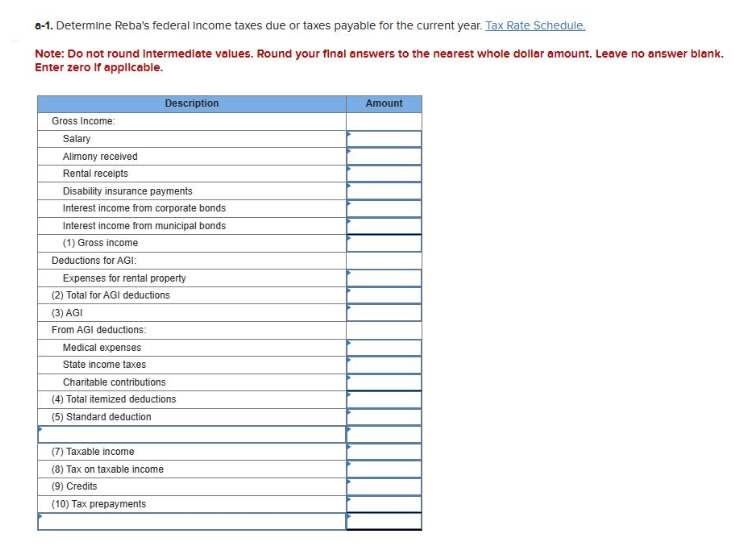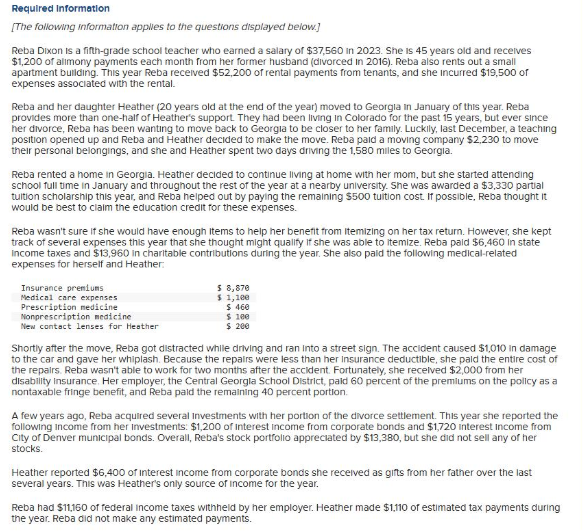! Required Information [The following information applies to the questions displayed below.] Reba Dixon is a fifth-grade school teacher who earned a salary of $37,560 in 2023. She is 45
years old and receives $1,200 of alimony payments each month from her former husband (divorced in 2016). Reba also rents out a small apartment building. This year Reba received $52,200 of rental payments from tenants, and she incurred $19,500 of expenses associated with the rental. Reba and her daughter Heather (20 years old at the end of the year) moved to Georgia in January of this year. Reba provides more than one-half of Heather's support. They had been living in Colorado for the past 15 years, but ever since her divorce, Reba has been wanting to move back to Georgia to be closer to her family. Luckily, last December, a teaching position opened up and Reba and Heather decided to make the move. Reba paid a moving company $2,230 to move their personal belongings, and she and Heather spent two days driving the 1,580 miles to Georgia. Reba rented a home in Georgia. Heather decided to continue living at home with her mom, but she started attending school full time in January and throughout the rest of the year at a nearby university. She was awarded a $3,330 partial tuition scholarship this year, and Reba helped out by paying the remaining $500 tuition cost. If possible, Reba thought it would be best to claim the education credit for these expenses. Reba wasn't sure if she would have enough Items to help her benefit from itemizing on her tax return. However, she kept track of several expenses this year that she thought might qualify if she was able to itemize. Reba paid $6,460 in state income taxes and $13,960 in charitable contributions during the year. She also paid the following medical-related expenses for herself and Heather: Insurance premiums Medical care expenses Prescription medicine Nonprescription medicine New contact lenses for Heather $ 8,870 $ 1,100 $ 460 $ 100 $ 200 Shortly after the move, Reba got distracted while driving and ran into a street sign. The accident caused $1,010 in damage to the car and gave her whiplash. Because the repairs were less than her insurance deductible, she paid the entire cost of the repairs. Reba wasn't able to work for two months after the accident. Fortunately, she received $2,000 from her disability Insurance. Her employer, the Central Georgia School District, paid 60 percent of the premiums on the policy as a nontaxable fringe benefit, and Reba paid the remaining 40 percent portion. A few years ago, Reba acquired several investments with her portion of the divorce settlement. This year she reported the following income from her investments: $1,200 of interest income from corporate bonds and $1,720 interest Income from City of Denver municipal bonds. Overall, Reba's stock portfolio appreciated by $13,380, but she did not sell any of her stocks. Heather reported $6,400 of Interest Income from corporate bonds she received as gifts from her father over the last several years. This was Heather's only source of income for the year. Reba had $11,160 of federal income taxes withheld by her employer. Heather made $1,110 of estimated tax payments during the year. Reba did not make any estimated payments. a-1. Determine Reba's federal income taxes due or taxes payable for the current year. Tax Rate Schedule. Note: Do not round Intermediate values. Round your final answers to the nearest whole dollar amount. Leave no answer blank. Enter zero if applicable. Gross Income: Salary Description Alimony received Rental receipts Disability insurance payments Interest income from corporate bonds Interest income from municipal bonds (1) Gross income Deductions for AGI: Expenses for rental property (2) Total for AGI deductions (3) AGI From AGI deductions: Medical expenses State income taxes Charitable contributions (4) Total itemized deductions (5) Standard deduction (7) Taxable income (8) Tax on taxable income (9) Credits (10) Tax prepayments Amount ! Required information [The following information applies to the questions displayed below.] Ken is 63 years old and unmarried. He retired at age 55 when he sold his business, Understock.com. Though Ken is retired, he is still very active. Ken reported the following financial information this year. Assume Ken files as a single taxpayer. a. Ken won $1,440 in an illegal game of poker (the game was played in Utah, where gambling is illegal). b. Ken sold 1,240 shares of stock for $32 a share. He inherited the stock two years ago. His tax basis (or investment) in the stock was $31 per share. c. Ken received $27,400 from an annuity he purchased eight years ago. He purchased the annuity, to be paid annually for 20 years, for $230,160. d. Ken received $13,600 in disability benefits for the year. He purchased the disability insurance policy last year. e. Ken decided to go back to school to learn about European history. He received a $740 cash scholarship to attend. He used $420 to pay for his books and tuition, and he applied the rest toward his new car payment. f. Ken's son, Mike, instructed his employer to make half of his final paycheck of the year payable to Ken as a gift from Mike to Ken. Ken received the check on December 30 in the amount of $1,460. g. Ken received a $730 refund of the $3,840 in state income taxes his employer withheld from his pay last year. Ken claimed $13,240 in itemized deductions last year (the standard deduction for a single filer was $12,950). h. Ken received $32,400 of interest from corporate bonds and money market accounts. 2. Complete page 1 of Form 1040 through line 9 and Schedule 1 for Ken. Note: Input all the values as positive numbers. Enter any non-financial information, (e.g. Names, Addresses, social security numbers) EXACTLY as they appear in any given information or Problem Statement. Use 2023 tax rules regardless of year on tax form. Ken does not wish to contribute to the Presidential Election Campaign fund and did not have any virtual currency transactions or interests. 2023 Tax Rate Schedules Individuals Schedule X-Single If taxable income is over: But not over: $ 0 $ 11,000 $ 11,000 $ 44,725 $ 44,725 $ 95,375 $ 95,375 $ 182,100 $ 231,250 $ 182,100 $ 231,250 $ 578,125 $ 578,125 - The tax is: 10% of taxable income $1,100 plus 12% of the excess over $11,000 $5,147 plus 22% of the excess over $44,725 $16,290 plus 24% of the excess over $95,375 $37,104 plus 32% of the excess over $182,100 $52,832 plus 35% of the excess over $231,250 $174,238.25 plus 37% of the excess over $578,125 Schedule Y-1-Married Filing Jointly or Qualifying surviving spouse If taxable income is over: But not over: $ 0 $ 22,000 $ 89,450 $ 190,750 $ 364,200 $462,500 $ 693,750 $ 22,000 $ 89,450 $ 190,750 $ 364,200 $ 462,500 $ 693,750 The tax is: 10% of taxable income $2,200 plus 12% of the excess over $22,000 $10,294 plus 22% of the excess over $89,450 $32,580 plus 24% of the excess over $190,750 $74,208 plus 32% of the excess over $364,200 $105,664 plus 35% of the excess over $462,500 $186,601.5 plus 37% of the excess over $693,750 Schedule Z-Head of Household If taxable income is over: But not over: $ 0 $ 15,700 $ 15,700 $ 59,850 $ 59,850 $ 95,350 $ 95,350 $ 182,100 $231,250 $ 578,100 $ 182,100 $231,250 $ 578,100 The tax is: 10% of taxable income $1,570 plus 12% of the excess over $15,700 $6,868 plus 22% of the excess over $59,850 $14,678 plus 24% of the excess over $95,350 $35,498 plus 32% of the excess over $182,100 $51,226 plus 35% of the excess over $231,250 $172,623.5 plus 37% of the excess over $578,100 Schedule Z-Head of Household If taxable income is over: But not over: $ 0 $ 15,700 $ 59,850 $ 95,350 $ 182,100 $231,250 $ 578,100 $ 15,700 $ 59,850 $ 95,350 $ 182,100 $231,250 $ 578,100 The tax is: 10% of taxable income $1,570 plus 12% of the excess over $15,700 $6,868 plus 22% of the excess over $59,850 $14,678 plus 24% of the excess over $95,350 $35,498 plus 32% of the excess over $182,100 $51,226 plus 35% of the excess over $231,250 $172,623.5 plus 37% of the excess over $578,100 Schedule Y-2-Married Filing Separately If taxable income is over: But not over: $ 0 $ 11,000 $ 44,725 $ 95,375 $ 182,100 $231,250 $ 346,875 $ 11,000 $ 44,725 $ 95.375 $ 182,100 $231,250 $ 346,875 The tax is: 10% of taxable income $1,100 plus 12% of the excess over $11,000 $5,147 plus 22% of the excess over $44,725 $16,290 plus 24% of the excess over $95,375 $37,104 plus 32% of the excess over $182,100 $52,832 plus 35% of the excess over $231,250 $93,300.75 plus 37% of the excess over $346,875




